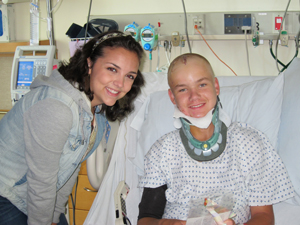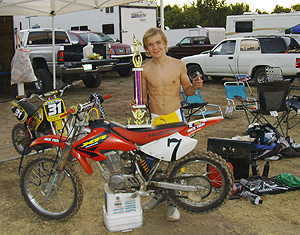Packard Children’s surgeon helps teen recover from brain injury
Packard Children’s surgeon helps teen recover from brain injury

- The brain injury Spencer Morse suffered required difficult surgery, and he was flown by Life Flight from Sonora, Calif., to Packard Children’s.
Spencer’s mom, Nina, was at home nearby, in Sonora, Calif., getting ready for her shift as an ICU nurse at Sonora Regional Medical Center when she was alerted to the accident. Spencer had regained consciousness but was being taken by ambulance to the hospital. Nina made it to the ER just before a doctor lifted the bandage off Spencer’s head.
“It was pulsing blood,” Nina said. “We knew we were in trouble.”
Spencer had a serious brain injury, and the Sonora hospital doesn’t handle such complex traumatic brain injuries. Spencer’s caregivers knew that they needed to airlift him to another facility. Nina asked that he be taken to Lucile Packard Children’s Hospital. Soon Spencer was in a Life Flight helicopter to Palo Alto. Nina and Spencer’s dad, Michael, followed by car.
An operating room was waiting when Spencer arrived at Packard Children’s. Neurosurgeon Michael Edwards, MD, could immediately see two things: the location of Spencer’s injury was lucky but his life was still in danger.
“He had a severe open injury to his skull,” Edwards said. The wound was just above Spencer’s hairline on the right side of his head. “Because it was in the right frontal lobe, he had no paralysis, and was talking and following commands. But the obvious risk was that he would continue to hemorrhage and would die.”
Even if he lived, the bleeding could cause lasting brain damage, and infection was also a significant concern, Edwards added.
The trauma team got to work. After anesthetizing Spencer, they began the delicate job of cleaning dirt, hair, blood clots and bone fragments out of the wound. The largest pieces of bone were soaked in antibiotic solution, and Edwards used a powerful surgical microscope to help remove every bit of debris from Spencer’s brain. When the wound was clean, the team switched into repair mode, fixing the dura, or brain-covering membrane, and reassembling the clean bone fragments like puzzle pieces at the site of the injury. Then they sewed up the jagged scalp wound.
The surgery was already under way when Nina and Michael arrived at the hospital. But Spencer’s care team had been in contact throughout their three-hour drive.

- Morse enjoyed competing in motocross until an accident in July in which his helmet came off.(Courtesy of the Morse family)
After surgery, Spencer spent three days in the pediatric intensive care unit. The team watched closely for signs of infection and gave intravenous doses of three strong antibiotics.
The Packard Children’s staff also paid attention to the needs of the rest of the Morse family, part of the hospital’s family-centered care effort, which recognizes that partnership between patients’ families and caregivers is the key to quality health care.
“The nurses were wonderful — they let me sit in on rounds, asked if I had any questions and kept me in the loop,” Nina said.
Nina and Michael were soon joined at the hospital by Spencer’s older siblings. As the family began taking shifts at Spencer’s bedside, a Packard case manager, Alison Harvey, helped them find a place to stay near the hospital.
“We always felt taken care of,” Nina said.
Three days after his surgery, Spencer turned a corner. The swelling came down and his bandages were removed. Best of all, Spencer was conversant and not showing any signs of lasting brain damage. His family began to breathe easier.
A week after surgery, although he was still receiving intravenous antibiotics and had his neck immobilized in a C collar, Spencer was well enough to go home.
But the care didn’t end there. Case manager Harvey stayed in contact with the Morse family, answering their questions at home and ensuring they received the right follow-up care in Sonora. Spencer also returned to Palo Alto for speech therapy and cognitive assessments to monitor his recovery.
Today, in spite of the severity of his traumatic brain injury, Spencer’s life is back to normal. He recently started 10th grade and has returned to many of his favorite activities, including playing golf andworking at the local skateboard and snowboard shop. But he chose not to go back to motocross racing. His bike is now up for sale on eBay.
“He came through this pretty unscathed,” Edwards said, adding that Packard Children’s high standard of care played an important role in Spencer’s good outcome.
“We’re used to handling very, very difficult pediatric cases,” Edwards said. “This fits into the realm of acuity that we deal with all the time.”
From Spencer’s perspective, the best thing about Packard Children’s was that “it didn’t feel too much like a hospital,” he said. “They just made you feel really comfortable. I wouldn’t want to be anywhere else.”
Nina agreed. “It was an incredible experience knowing that he was getting the best care available. I am just so grateful.”
* Stanford University Medical Center integrates research, medical education and patient care at its three institutions – Stanford University School of Medicine, Stanford Hospital & Clinics and Lucile Packard Children’s Hospital. For more information, please visit the Office of Communication & Public Affairs site at http://mednews.stanford.edu/
** The above story is reprinted from materials provided by Stanford University School of Medicine
________________________________________________________________
![]()

![]()


















